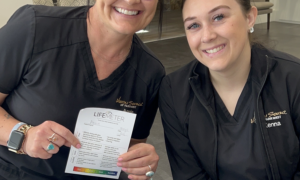 By Janelle Davison, OD
By Janelle Davison, OD
Sept. 8, 2021
Providing a high level of care is made easier for both patient and practice when you have a simple way for patients to fulfill the eyewear prescriptions you write. In our practice, we found that lens packages that ensure each patient gets quality eyewear, no matter what they choose, is a game-changer.
Offering those lens packages was made easier for us with a software system, Paradeyem, we developed ourselves, and are now making available to other practices, too.
Patients Can Never Go Wrong in What They Purchase From Us
Our patients must choose from the following three packages with the option of adding additional lens treatments to any of the packages, which all include polycarbonate and anti-reflective lenses (blue light filter, Transitions Lenses, dry-eye kits and other products):
Trendsetter: Polycarbonate Aspheric top-tier AR single-vision or top-of-the market AR progressive and in-office extended warranty and anti-fog spray.
Premium: Polycarbonate AR single-vision or mid-market option progressive lens.
Basic: Polycarbonate AR single-vision, polycarbonate AR progressive or CR-39 AR flattop
Transitions Lenses and polarized lenses are examples of lens-adds that can be added to any of these packages for an additional fee (with the entire transaction done within the software).
Most patients who visit an eye doctor’s office know little about their spectacle lens options. For that reason, having them buy lens options from you in an itemized fashion can be overwhelming and lead to poor decision-making. The patient is likely to ask for the simplest lens, forgoing the additional lens features the doctor prescribed. From a patient care perspective we can rest easy knowing that even our most basic package option offers a polycarbonate lens with AR. I know I won’t have patients coming back to my office complaining about glasses that were easily scratched and too full of glare to see.
Less than 2 percent of our patients choose the most basic lens package. After we educate patients about the benefits of each package, they almost ways opt for more, rather than fewer, beneficial lens features.
Build On Already Great Options
The three lens packages are just the base from which I prescribe lens add-ons that personalize our patients’ care. For example, if a patient is at risk for cataracts, I would prescribe Transitions Lenses. When I hand off the patient to the optical, one of our opticians might say: “Lets go over your lens options. Let’s look at the add-ons the doctor has prescribed first. We want to make sure we incorporate photochromatic lenses because you are at early risk for cataracts.” Through the software, I would assign an attribute to a patient that would automatically recommend that the optician add on Transitions Lenses.
The optician would then say: “We have three lens package options. Based on your insurance plan, this is what you pay out of pocket for each package option, with the cost of the photochromatic lenses added in. The only thing that will change that price are the frames you choose.”
A Technology that Makes Calculating Cost of Packages Easy for Opticians
Such fast and accurate calculations are possible because of a technology we introduced to our office over a year ago. It’s much easier to implement lens packages in your office if your opticians have an almost wholly automated way of calculating the cost for patients. That’s where Paradeyem (pronounced “paradigm”) comes into play. Created by my husband, who is also our practice’s chief financial officer, the technology allows my staff to input my recommendations for each patient’s lenses, along with the patient’s insurance.
After inputting the co-pays, the software then instantly calculates what the patient’s out-of-pocket costs will be for their new glasses. There is now no need for our opticians to do these calculations themselves, eliminating the frequent errors in how much patients were charged that we noticed occurring.
Other Articles to Explore
My opticians can now input the co-pays for the patient insurance into the software, along with my recommendations, and the software will tell the patient how much each package will cost them, including the cost for additional lens treatments I may have recommended that are not included in the package the patient chose.
If we are short-staffed, we can even load into the software ahead of time lens price quotes, based on each patient’s insurance, before the start of the day. The staff member on duty then just has to input into the software the cost of the frame and any lens add-ons I prescribe to arrive at the final cost to the patient. Saving the quotes ahead of time makes it only a five-minute transaction at the time of sale.
Before we organized our offerings to patients into lens packages, we sold 60 percent AR. Now 100 percent of glasses we sell have AR. We went from 70 percent polycarbonate to 90 percent polycarbonate.
Our average per patient revenue in 2021 is now $470 ($553 in Q2 2021). Before we had the software system and lens packages, our average per patient revenue was $338. Our revenue per exam increased 30-40 percent.
Paradeyem has worked so well for our practice that we have started offering it as a low-cost subscription to other practices. Click HERE to learn more and request a demo.

The proprietary software system, Paradeyem, which Dr. Davison’s chief financial officer and husband created. The system makes it easy for opticians to input patient information to quickly and accurately calculate patient charges.
Make Delighted Patients More Likely
It’s common for patients to get their hearts set on a frame they love first, and then consider the cost of the lenses. Paradeyem lets patients know what the cost of their lenses will be before they ever pick out a frame. The software calculates what the cost of the lenses for each package will be after the patient’s insurance has been applied, so the patient knows right off the bat how much they will need to pay for each lens package before they shop for their frame. They then can make a decision that puts their vision on par with fashion in the choice they make. They know how much they can spend on the frame for their new glasses.
Getting the decision on the lenses settled first also makes it easier for our opticians to work with the patient to find a lens that is appropriate for their prescription. That ability for advance planning, combined with the lens price quote we are able to give patients before they browse, makes it more likely that patients will leave our office with glasses they love.
 Janelle Davison, OD, is the owner of Brilliant Eyes Vision Center in Smyrna, Ga. To contact her: info@brillianteyesvisioncenter.com
Janelle Davison, OD, is the owner of Brilliant Eyes Vision Center in Smyrna, Ga. To contact her: info@brillianteyesvisioncenter.com



























